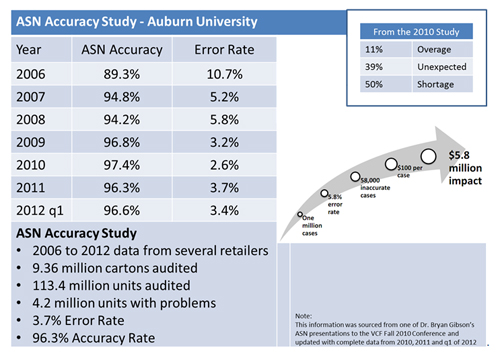|
|
About the Author |
|
Kevin Harris
Director of Freight Data and Marketing
Compliance Networks
Kevin Harris has over 11 years of experience as a project and marketing manager with Compliance Networks, helping retailers develop and implement process and profit-improvement solutions. Kevin has managed successful distribution operations for very large and small retailers and manufacturers. He got his start in operations and logistics in 1983 as an infantry officer in the U.S. Army, serving in the 3rd Ranger Battalion.
For more information, please visit www.compliancenetworks.com.
|
|
Supply Chain Comment
By Kevin Harris,
Director of Freight Data and Marketing, Compliance Networks
December 5, 2013
|
ASN Accuracy, The PO LifeCycle, and Fun With Pictures
Plain Language, A Compelling Study and Graphics that Make the Case for Improving ASN Accuracy
|
Harris Says: |
 |
| Our experience is that many people believe if the ASN is technically correct and passes all validation, they are good and merchandise can flow, inventory can be booked and invoices paid. |
|
What Do You Say?
|
|
|
|
Our Guest Experts |
|
|
In our work with retailers and suppliers we are often amazed when supply chain practitioners ignore the fact that ASN accuracy directly affects inventory accuracy. Our experience is that many people believe if the ASN is technically correct and passes all validation, they are good and merchandise can flow, inventory can be booked and invoices paid.
The concern is when the contents of the cartons do not match the content of the ASN, which happens more than 4% of the time, as determined by a study by Dr. Bryan Gibson of Auburn University. A summary of Dr. Gibson’s findings is in the graphic below. Please note that the retailers studied were engaged in ongoing programs to improve ASN Accuracy. The improvement you see over time did not just happen all by itself.

It might sound small but it can have a snowball effect. Consider replenishment merchandise with small quantities and a great number of UPCs or items. With inaccurate inventories you can frequently get “ghost” inventory (system thinks you have 3 when you actually have 0). If your order point is 2, it is impossible to sell one to get down to the point where the item will be automatically reordered. Now multiply this over tens of thousands of items and hundreds of stores. This is a really BIG deal. The ASN and PO lifecycle workflow below describes opportunities throughout the PO lifecycle for retailers to verify ASN Accuracy and actions to take when discrepancies are discovered.
|
|
|
More detailed workflows developed at a series of workshops hosted by the Retail Value Chain Federation may be viewed or downloaded here. Dr. Gibson’s study can be viewed or downloaded here.
For more information, more fun pictures, or answers to questions, feel free to contact the Compliance Networks team at info@compliancenetworks.com.
|
Agree or Disagree with Our Expert's Perspective? Let Us Know Your Thoughts at the Feedback section below. |
|
|
|
Recent Feedback |
I could not agree more with the article itself.
What needs to be analysed, with responsibility properly affixed, are the processes of that create and issue the ASN: those of the shipper. Why are some ASNs habitually incorrect? One of the most solvable reasons is systematic and structural: in the experience of myself and numerous colleagues, many of these 3.7% incorrect ASNs are wrong because they are NOT in fact a record of has been packed and shipped; rather, they are simply a "copy & paste" version of the distribution "pick list" which has not been properly corrected--for items that could not be picked and those that were mispicked and shipped.
One possible solution for this problem, which could also solve the problems of some retailer deductions and the length of time until invoice payment is settled, would be to create the pick list directly while the conveyance is loaded, either reading passive RFID tags or a bar code scanner directly on the conveyor which is extended into the trailer or container for individual case pack loading. This was previously discussed in Supply Chain Digest 30 March, 2011 (http://www.scdigest.com/ontarget/11-03-30-1.php?cid=4372&ctype=content), a version of the article originally published in January, 2005 (http://www.cargointelligence.org/publications/files/JHM_RFID_article_0105.pdf).
The shipper community deserves strong credit for the improvements seen up through 2009, but our increasingly integrated Supply Chain Networks will require that all systematic errors be eliminated--we hope that is only a matter of system changes, rather than the usual alternatives.
Joe McKinney
Managing Director
SCV Solutions
Jan, 29 2014
|
|
|
| |
|
|
|